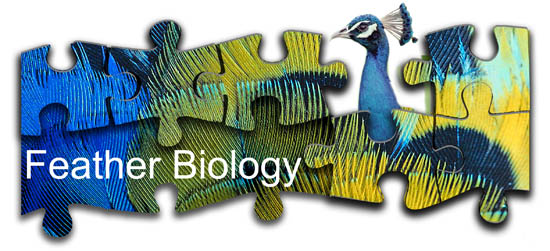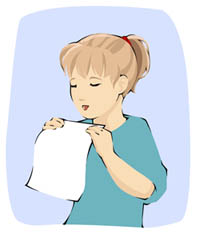
Illustrated by: Sabine Deviche
Flights of Fantasy
Almost everyone has wished at one time or another to be able to fly like a bird. Just the thought of soaring above your city or town without any mechanical device gives us a reason to envy these feathered animals.
So why can't humans fly and what makes birds so special that they are able to take to the air without needing a plane or a glider? The basic answer is they have feathers and also bones that are hollow, making them light and still strong. But there is more to the story of feathers than just flying. In fact bird feathers have a lot of different uses.
Not Just For Flying?
While feathers are needed to fly they also have a lot of other uses. How many ways are feathers used by birds? It turns out there are around 23 different ways birds use their feathers. Not all birds use their feathers in the same way, but as a group they use their feathers in many creative and interesting ways.
Feather Functions
How many ways do you think birds use their feathers? Think about it and if your list gets very long you should write them down. Once you finish compare your list to ours. Just be sure to make your list before you click on the link! | 23 Feather Functions |

Have you ever wondered how birds fly? What is it that lifts them off the ground and lets them fly and glide through air? Try this activity and you might just get a clue.
Take a piece of paper. The best type of papers to use are the thin sheets used in magazines.
Hold the short edge of the paper up to your mouth using both hands.
What do you think will happen if you blow hard across the top of the paper? Will it go down or up? Now try it. Learn More
Types of Feathers

Because feathers do so many jobs there needs to be more than one type of feather. Some of them are long and strong for flying and steering. Others are soft and fuzzy. These feathers are very good for keeping the bird warm. In fact, we have learned to use these soft feathers in our clothing and bedding to help keep us warm. You might have had a down comforter on your bed or wear a down jacket when it is cold outside. These are things that are filled with soft downy feathers.
If you look at the different feather types above, you will see that they come in many shapes and sizes. The types we see the most often are tail and flight feathers (also called vaned or contour feathers). At first look they may seem the same, but actually are different. Tail feathers are balanced left and right of the center. Flight feathers have a wider and narrower side. This makes them better for flying because they can cut through the air with very little resistance (also called drag).
Other types of feathers are made for use on the body of the bird. The downy feathers that are good for warmth are shown on the far right. Semiplume feathers also help to keep birds warm and they help water birds float. The bristle feathers are found around the eyes and nostrils, and for some birds that like to catch flying insects they can be seen around their mouths. Filoplume (file-o-ploom) feathers can be found around the tail and flight feathers. They are thought to be used to sense when the flight feathers need to be maintained.
No matter what type of feather, they all have similar parts. Below is a drawing of a feather showing all the parts that you might find on a feather. Not all feathers have all the parts. For example downy feathers are missing the stiff barbs and vane. You will also see that flight feathers have very little or no downy barbs.
Feather Anatomy

Feather Color
Some bird feathers also show amazing colors. Many of the colors are very different than what you and I might see on the walls in our house or school. These colors are made by bending light to create different colors. This type of color is called iridescence. Iridescent things have some interesting abilities. Depending on the angle you look at an iridescent object, it can actually change color.
What Are Feathers Made Of?
If you hold out your hand and look at the nails on your fingers, or touch the hair on your head you are seeing and touching the same type of material that feathers are made from - keratin. Keratin is a very strong and light material. This makes it perfect for birds that need to be light so that they can fly. Besides feathers some other parts of birds are made of keratin: beaks and talons (claws).
Have you ever wondered why birds don’t have teeth? Instead of teeth, birds use their strong beak for eating. They can use their beak to pick up or crack open food, and otherwise use their beak the way other animals might use their teeth. But these strong beaks are lighter than teeth. Some biologists think this keeps the bird's head from being too heavy and making the body unbalanced for flying.
Feather Views

See for yourself. We have assembled a gallery of feathers that you can look at as well as zoom in on to see them better than if you were holding them in your own hand.
References: Stettenheim, Peter. What Feathers Do. Birder's World. June 2006: 25-34.
Acknowledgements: We thank David Pearson and Kevin McGraw for their feedback and suggestions on this article and Nancy Pearson for the use of her tobogganing penguin image. The bird feathers in the gallery were made possible thanks to Chris Maynard and Kevin McGraw.
Read more about: Feather Biology
Bibliographic details:
- Article: Feather Biology
- Author(s): CJ Kazilek
- Publisher: Arizona State University School of Life Sciences Ask A Biologist
- Site name: ASU - Ask A Biologist
- Date published: 11 Aug, 2009
- Date accessed:
- Link: https://askabiologist.asu.edu/explore/feather-biology
APA Style
CJ Kazilek. (Tue, 08/11/2009 - 15:57). Feather Biology. ASU - Ask A Biologist. Retrieved from https://askabiologist.asu.edu/explore/feather-biology
Chicago Manual of Style
CJ Kazilek. "Feather Biology". ASU - Ask A Biologist. 11 Aug 2009. https://askabiologist.asu.edu/explore/feather-biology
CJ Kazilek. "Feather Biology". ASU - Ask A Biologist. 11 Aug 2009. ASU - Ask A Biologist, Web. https://askabiologist.asu.edu/explore/feather-biology
MLA 2017 Style

If you like feathers, try exploring them in the Zoom Gallery.
Be Part of
Ask A Biologist
By volunteering, or simply sending us feedback on the site. Scientists, teachers, writers, illustrators, and translators are all important to the program. If you are interested in helping with the website we have a Volunteers page to get the process started.



